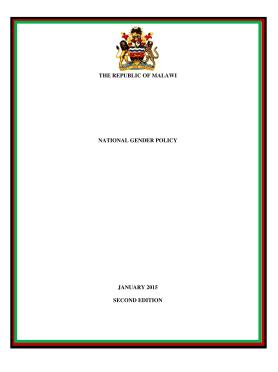Malawi National Gender Policy 2015
Malawi National Gender Policy 2015
The National Gender Policy provides guidelines for mainstreaming gender in various sectors of the economy with the overall goal of reducing gender inequalities and enhancing participation of women, men, girls and boys in socio economic and political development.
This policy draws from the 2000-2005 National Gender Policy whose overall goal was to mainstream gender in the national development process to enhance participation of women and men, girls and boys for sustainable and equitable development for poverty eradication. It further draws from regional and international instruments to which Malawi is a party. The persistence of gender inequalities and under representation of women in decision making positions at all levels continue to provide the need for a gender policy to provide the policy framework for addressing them.
The need to review the 2000-2005 National Gender Policy was necessitated in 2005 after realizing that, in addition to several achievements made, there were a number of challenges, emerging issues and lessons learnt during the implementation of the first Policy. Some of the lessons learnt include, inter alia, gender equality can be achieved if it is well institutionalized, provision of guidance on how to mainstream gender issues in national development processes, and disseminations of sector specific gender mainstreaming guidelines, capacity building of stakeholders, strengthening networking , coordination and collaboration between and among stakeholders and implementation of comprehensive and well coordinated programmes with monitoring and evaluation systems. The current major challenges and emerging issues highlighted in most reviews include HIV and AIDS, decision making in reproductive and other health issues, persistent gender based violence (GBV), human trafficking, child labor, increased environmental degradation, climate change and high levels of poverty. All these challenges and emerging issues have gender dimensions.

